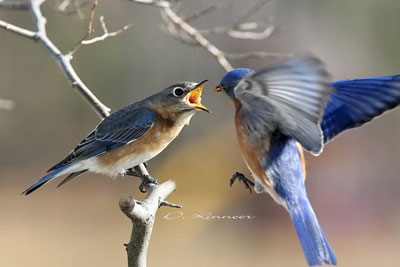
Allofeeding is when a bird passes food to another bird. (I use it to refer to adults vs. parents or helpers feeding young. Some definitions of allofeeding may not include males feeding their mates.)
The reasons one bird offers food to another bird probably include:
- Courtship: A mating ritual, sometimes in response to begging calls and wing quivering/shivering.
- This might be to “test” the male’s ability to forage and provide for young. It could be an indicator of the odds of successfully breeding. It can occur during copulation, nestbuilding and/or egg laying.
- to reinforce or maintain a pair bond.
- to increase a female’s fitness by providing her with extra food, which probably increases the quality of her eggs or may advance the laying date.
- Nesting: this allows the female to remain on the nest, instead of having to go out and find her own food. It means the eggs or young are kept at an even temperature, and also protects them from predators like marauding House Wrens that sneak in when the parents are not around to peck eggs or kill small nestlings. When feeding an incubating female, the male may call to her softly.
- “Anticipatory food-bringing” may occur in the later stages of incubation, perhaps as the male ‘practices” bringing food to the young to come.
- Also see “helping” (cooperative breeding) where individuals other than the male–female pair help to raise a brood.
- Other:
- In some species, a subordinate bird may bring food to a dominant individual. Both birds may be the same sex. The food is often refused, and the dominant bird may even chase off or attack the subordinate. Allofeeding among adults has been observed in Florida Scrub Jays, Arabian Brown Babblers, Social Weavers, and captive Eurasian Siskins.
- There are a few reports of birds bringing food to an injured bird.
- In species like Titmice or Chickadees the young look almost identical to adults (sometimes they are smaller). Newly fledged young will often beg from their parents for several weeks after leaving the nest, until they are weaned and can fend for themselves.
References and More Information:
- Helping – fledglings feeding nestlings (with video)
- Smith, S.M, 1980. Demand “sizemed”>Senar, Juan Carlos, 1984. Allofeeding in Eurasian Siskins (Carduelis Spinus). The Condor 86:213-214.
- Cooperative feeding between different species
– John Burroughs, The Bluebird, 1867
